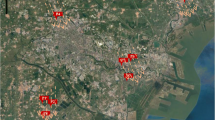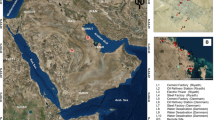Abstract
Polychlorinated dibenzo-p-dioxins (PCDDs) and polychlorinated dibenzofurans (PCDFs) consist of a group of organohalogenated compounds which are ubiquitous, anthropogenic, toxic and persistent organic pollutants. Human exposure to PCDD/Fs is associated with severe health risks. In the current study, levels of PCDD/Fs were determined in soil from municipal waste (MW) dumping site and ash residues from hospital waste incinerators (HWIs) and brick kilns (BKs) in Peshawar, Khyber Pakhtunkhwa (KP) Province, Pakistan. A total of 17 congeners (7 PCDDs and 10 PCDFs) were quantified using high-resolution gas chromatography/high-resolution mass spectrometry (HRGC/HRMS) 6890 Series (Agilent, USA). The PCDD/Fs contamination levels in the studied samples followed an order of HWIs > BKs > MW dumping site. Among HWIs, highest toxicity values of 2343 ng international toxicity equivalency factors (I-TEQ)/kg and 2138 ng World Health Organization-toxicity equivalents quantity (WHO-TEQ)/kg were observed for Khyber Teaching Hospital (KTH), while toxicity values for Hayatabad Medical Complex (HMC) were found to be 1493 ng I-TEQ/kg and 1416 ng WHO-TEQ/kg, respectively. The TEQ values were found in order of HWIs > BKs > MW site. Potential for both non-cancer and cancer risk (CR) in three pathways was found in order as ingestion > dermal > inhalation. Based on the finding it can be inferred that the onsite workers and general public exposed to such levels are under potential risk for both carcinogenic and non-carcinogenic risk.



Similar content being viewed by others
References
Abad E, Llerena JJ, Saulo´ J, Caixach J, Rivera J (2000) Comprehensive study on dioxin contents in binder and anticaking agent feed additives. Organohalogen Compd 46:439–442
ARNIKA and SDPI (2006) POPs in residues from waste incineration in Pakistan, International POPs Elimination Project (IPEP) report, pp 5-44
Cariou R, Marchand P, Vénisseau A, Brosseaud A, Bertrand D, Qannari EM, Antignac JP, le Bizec B (2010) Prediction of the PCDD/F and dl-PCB 2005-WHO-TEQ content based on the contribution of six congeners: toward a new screening approach for fish samples? Environ Pollut 158(3):941–947
Chang MB, Lin JJ (2001) Memory effect on the dioxin emissions from municipal waste incinerator in Taiwan. Chemosphere 45(8):1151–1157
Chen HL, Shih TS, Huang PC, Hsieh CY, Lee CC (2006) Exposure of arc-furnace-plant workers to polychlorinated dibenzo-p-dioxins and dibenzofurans (PCDD/Fs). Chemosphere 64(4):666–671
Chen SJ, Tsai JH, Chang-Chien GP, Huang KL, Wang LC, Lin WY, Lin CC, Yeh CKJ (2017) Emission factors and congener-specific characterization of PCDD/Fs, PCBs, PBDD/Fs and PBDEs from an off-road diesel engine using waste cooking oil-based biodiesel blends. J Hazard Mater 339:274–280
Chopra M, Schrenk D (2011) Dioxin toxicity, aryl hydrocarbon receptor signaling, and apoptosis—persistent pollutants affect programmed cell death. Crit Rev Toxicol 41(4):292–320
Clarke B, Porter N, Symons R, Blackbeard J, Ades P, Marriott P (2008) Dioxin-like compounds in Australian sewage sludge–review and national survey. Chemosphere 72(8):1215–1228
Davy CW (2004) Legislation with respect to dioxins in the workplace. Environ Int 30:219–233
de Lacerda JP (2019) The history of the dioxin issue in Brazil: from citrus pulp crisis to food monitoring. Environ Int 122:11–20
De Rosa CT, Brown D, Dhara R, Garrett W, Hansen H, Holler J et al (1999) Dioxin and dioxin-like compounds in soil, part II: technical support document for ATSDR policy guideline. Toxicol Ind Health 15(6):558–576
Diaz LF, Savage GM, Eggerth LL (2005) Alternatives for the treatment and disposal of healthcare wastes in developing countries. Waste Manag 25(6):626–637
Fiedler H (2001) Thailand dioxin sampling and analysis program. UNEP Chemicals, Geneva, Switzerland
Fromme H, Albrecht M, Appel M, Hilger B, Völkel W, Liebl B, Roscher E (2015) PCBs, PCDD/Fs, and PBDEs in blood samples of a rural population in South Germany. Int J Hyg Environ Health 218(1):41–46
Fueno H, Tanaka K, Sugawa S (2002) Theoretical study of the dechlorination reaction pathways of octachlorodibenzo-p-dioxin. Chemosphere 48:771–778
Grochowalski A (1998) PCDDs and PCDFs concentration in combustion gases and bottom ash from incineration of hospital wastes in Poland. Chemosphere 37(9-12):2279–2291
Ho CC, Chan CC, Chio CP, Lai YC, Chang-Chien GP, Chow JC, Watson JG, Chen LWA, Chen PC, Wu CF (2016) Source apportionment of mass concentration and inhalation risk with long-term ambient PCDD/Fs measurements in an urban area. J Hazard Mater 317:180–187
Hoogenboom RL, Stark ML, Spolders M, Zeilmaker MJ, Traag WA, Ten Dam G, Schafft HA (2015) Accumulation of polychlorinated dibenzo-p-dioxins, dibenzofurans, and biphenyls in livers of young sheep. Chemosphere 122:137–144
Hossain MS, Balakrishnan V, Rahman NNNA, Sarker MZI, Kadir MOA (2012) Treatment of clinical solid waste using a steam autoclave as a possible alternative technology to incineration. Int J Environ Res Public Health 9(3):855–867
International POPs Eliminating Network, Dioxin, PCBs and Waste working group (IPEN) (2005) After incineration: the toxic ash problem. Report:1–65
Katami T, Yasuhara A, Okuda T, Shibamoto T (2002) Formation of PCDDs, PCDFs, and coplanar PCBs from polyvinyl chloride during combustion in an incinerator. Environ Sci Technol 36(6):1320–1324
Kwon HO, Kim CS, Lee YS, Choi MB (2019) Abundance of diet-derived polychlorinated dibenzo-p-dioxins and polychlorinated dibenzofurans in the bodies and nests of the yellow-legged hornet Vespa velutina nigrithorax and risks to human health in South Korea. Sci Total Environ 654:1033–1039
Lin X, Huang Q, Chen T, Li X, Lu S, Wu H, Yan J, Zhou M, Wang H (2014) PCDD/F and PCBz emissions during start-up and normal operation of a hazardous waste incinerator in China. Aerosol Air Qual Res 14:1142–1151
Ling YC, Hou PC (1998) A Taiwanese study of 2, 3, 7, 8-substituted PCDD/DFs and coplanar PCBs in fly ashes from incinerators. J Hazard Mater 58(1-3):83–91
Littarru P, Vargiu L (2003) Generation of PCDD/F in fly ash from municipal solid waste incinerators. J Air Waste Manage Assoc 53(8):914–917
Liu H, Kong S, Liu Y, Zeng H (2012) Pollution control technologies of dioxins in municipal solid waste incinerator. Procedia Environ Sci 16:661–668
Liu G, Jiang X, Wang M, Dong S, Zheng M (2015) Comparison of PCDD/F levels and profiles in fly ash samples from multiple industrial thermal sources. Chemosphere 133:68–74
Lonati G, Zanoni F (2012) Probabilistic health risk assessment of carcinogenic emissions from a MSW gasification plant. Environ Int 44:80–91
Malisch R (2000) Increase of the PCDD/F-contamination of milk, butter and meat samples by use of contaminated citrus pulp. Chemosphere 40:1041–1053
Malisch R, Kotz A (2014) Dioxins and PCBs in feed and food—review from European perspective. Sci Total Environ 491:2–10
Marquès M, Nadal M, Díaz-Ferrero J, Schuhmacher M, Domingo JL (2018) Concentrations of PCDD/Fs in the neighborhood of a hazardous waste incinerator: human health risks. Environ Sci Pollut Res 25(26):26470–26481
Minh NH, Minh TB, Watanabe M, Kunisue T, Monirith I, Tanabe S, Sakai S, Subramanian A, Sasikumar K, Viet PH, Tuyen BC, Tana TS, Prudente MS (2003) Open dumping site in Asian developing countries: a potential source of polychlorinated dibenzo-p-dioxins and polychlorinated dibenzofurans. Environ Sci Technol 37(8):1493–1502
Pan Y, Yang L, Zhou J, Liu J, Qian G, Ohtsuka N, Motegi M, Oh K, Hosono S (2013) Characteristics of dioxins content in fly ash from municipal solid waste incinerators in China. Chemosphere 92(7):765–771
Perelló G, Díaz-Ferrero J, Llobet JM, Castell V, Vicente E, Nadal M, Domingo JL (2015) Human exposure to PCDD/Fs and PCBs through consumption of fish and seafood in Catalonia (Spain): temporal trend. Food Chem Toxicol 81: 28-33.a
Program for Appropriate Technology in Health (PATH), (2005) Treatment alternatives for medical waste disposal. Washington USA
Pussente IC, Dam GT, Leeuwen SV, Augusti R (2017) PCDD/Fs and PCBs in soils: a study of case in the city of Belo Horizonte-MG. J Braz Chem Soc 28(5):858–867
Rordorf BF (1986) Thermal properties of dioxins, furans and related compounds. Chemosphere 15(9-12):1325–1332
Rovira J, Mari M, Nadal M, Schuhmacher M, Domingo JL (2011) Use of sewage sludge as secondary fuel in a cement plant: human health risks. Environ Int 37(1):105–111
Rovira J, Vilavert L, Nadal M, Schuhmacher M, Domingo JL (2015) Temporal trends in the levels of metals, PCDD/Fs and PCBs in the vicinity of a municipal solid waste incinerator. Preliminary assessment of human health risks. Waste Manag 43:168–175
Sadler R, Connell D (2012) Global distillation in an era of climate change. In Organic pollutants ten years after the Stockholm convention—environmental and analytical update. InpTech 191-216
Shih TS, Lee WJ, Shih M, Chen YC, Huang SL, Wang LC, Chang-Chien GP, Tsai PJ (2008) Exposure and health-risk assessment of polychlorinated dibenzo-p-dioxins and dibenzofurans (PCDD/Fs) for sinter plant workers. Environ Int 34(1):102–107
Srogi K (2008) Levels and congener distributions of PCDDs, PCDFs and dioxin-like PCBs in environmental and human samples: a review. Environ Chem Lett 6(1):1–28
Sun J, Hu J, Zhu G, Zhang D, Zhu Y, Chen Z, Li J, Zhang H, Tang J, Nie J, Zhang S (2017) PCDD/Fs distribution characteristics and health risk assessment in fly ash discharged from MSWIs in China. Ecotox Environ Safe 139:83–88
Tsukimori K, Uchi H, Tokunaga S, Yasukawa F, Chiba T, Kajiwara J, Hirata T, Furue M (2013) Blood levels of PCDDs, PCDFs, and coplanar PCBs in Yusho mothers and their descendants: association with fetal Yusho disease. Chemosphere 90(5):1581–1588
US EPA (2003) Exposure and human health reassessment of 2,3,7,8-tetrachlorodibenzo-p-dioxin and related compounds. National Academy Sciences review draft, Washington DC
US EPA Method 1613 (1994) Revision B: tetra- through octa-chlorinated dioxins and furans by isotope dilution HRGC/HRMS
Węgiel M, Chrząszcz R, Maślanka A, Grochowalski A (2018) Seasonal variations of PCDD/Fs congeners in air, soil and eggs from a Polish small-scale farm. Chemosphere 199:89–97
Wu S, Zhou J, Pan Y, Zhang J, Zhang L, Ohtsuka N, Motegi M, Yonemochi S, Oh K, Hosono S, Qian G (2016) Dioxin distribution characteristics and health risk assessment in different size particles of fly ash from MSWIs in China. Waste Manag 50:113–120
Acknowledgements
Financial support for this work was provided by the Higher Education Commission (HEC) of Pakistan.
Data availability (data transparency)
Not applicable.
Code availability (software application or custom code)
Not applicable.
Funding
Research was funded by the Higher Education Commission (HEC), Pakistan.
Author information
Authors and Affiliations
Corresponding author
Ethics declarations
Conflict of interest
The authors declare no competing interests.
Additional information
Responsible Editor: Amjad Kallel
Rights and permissions
About this article
Cite this article
Gul, N., Khan, B., Khan, H. et al. Levels of polychlorinated dibenzo-p-dioxins and dibenzofurans (PCDD/Fs) in municipal waste dumping site, incinerator and brick kiln residues: evaluation for potential risk assessment. Arab J Geosci 14, 741 (2021). https://doi.org/10.1007/s12517-021-07108-0
Received:
Accepted:
Published:
DOI: https://doi.org/10.1007/s12517-021-07108-0




